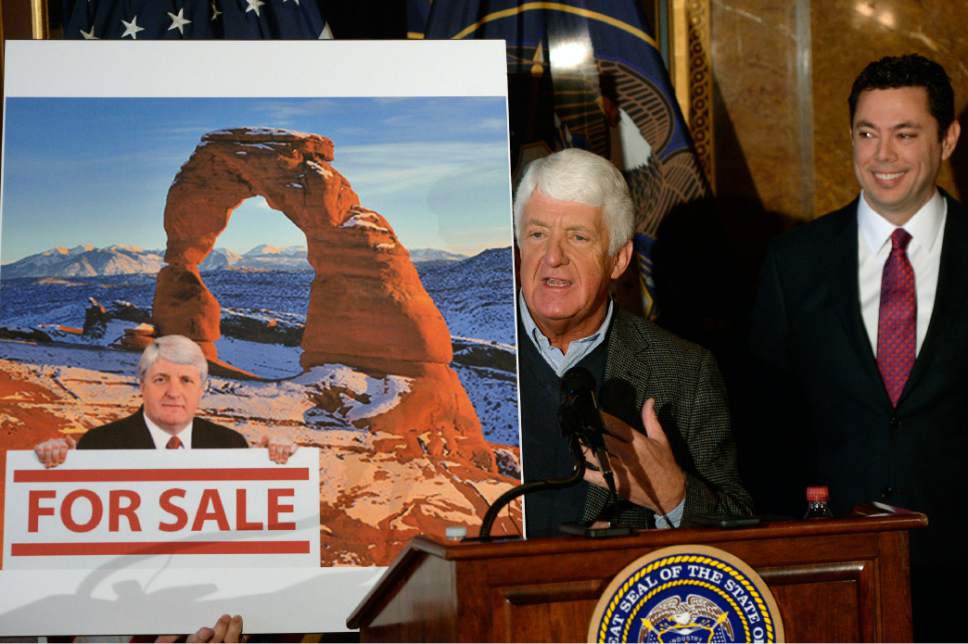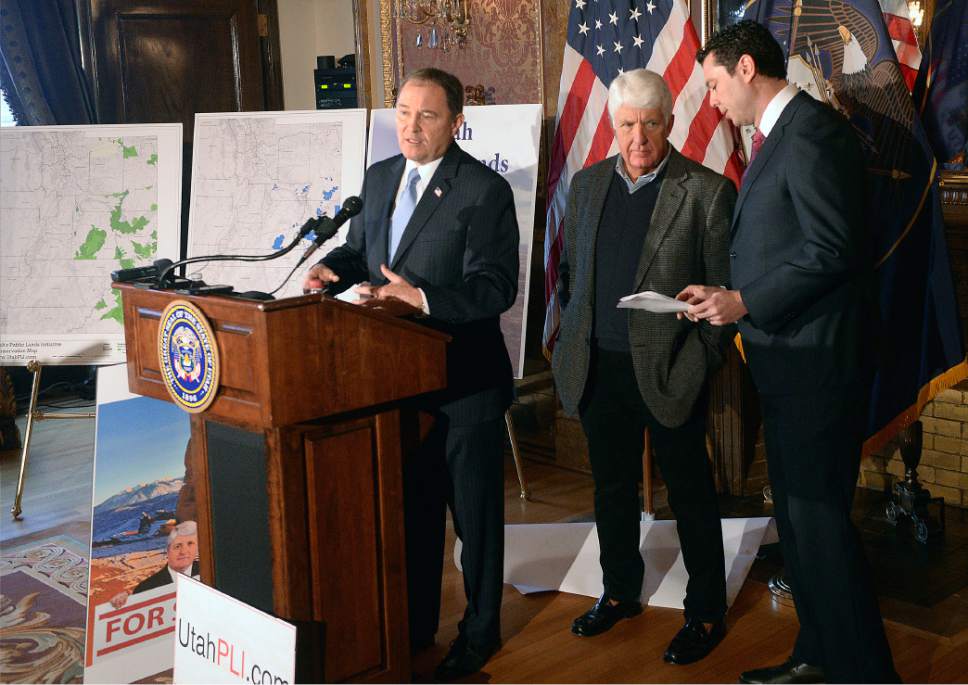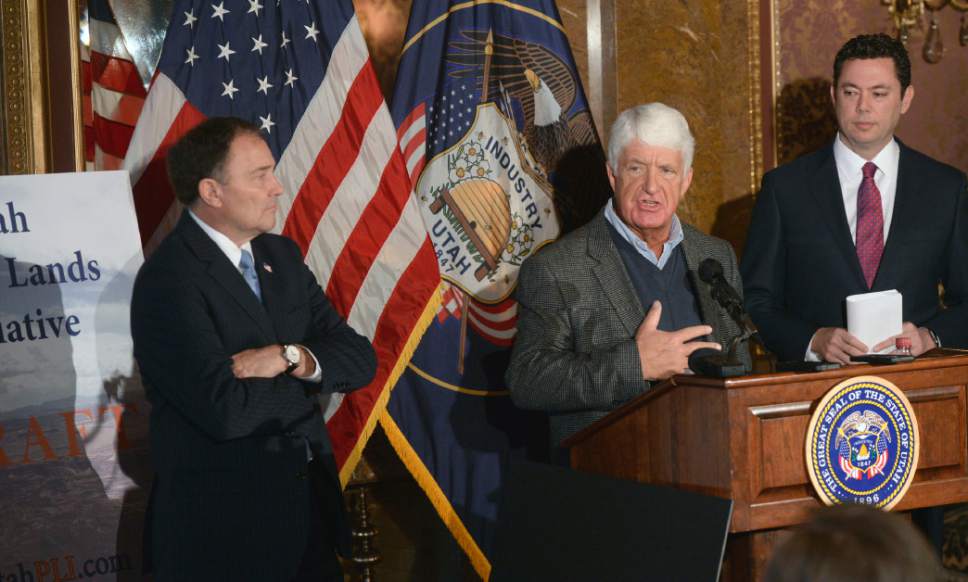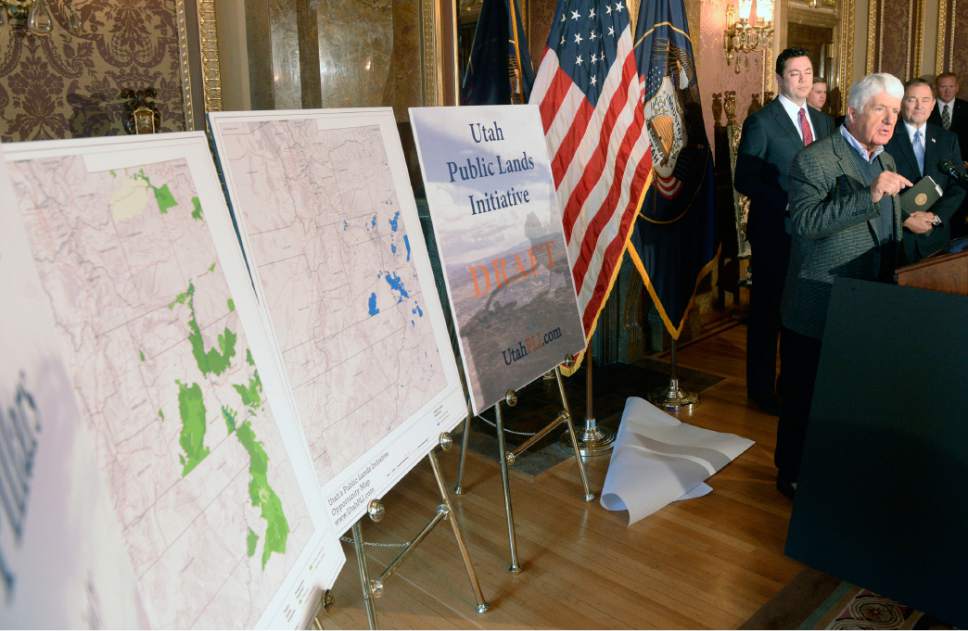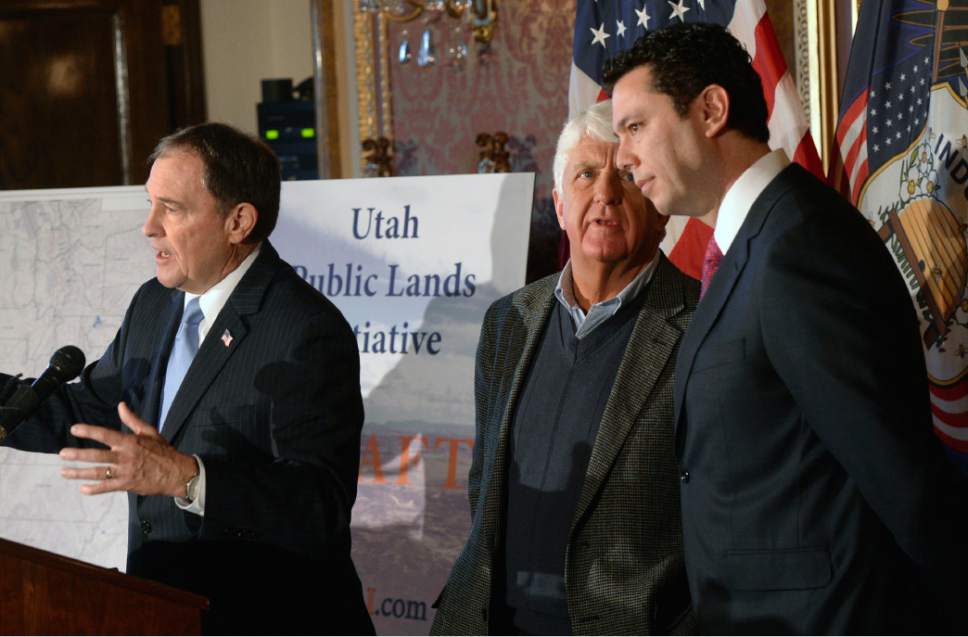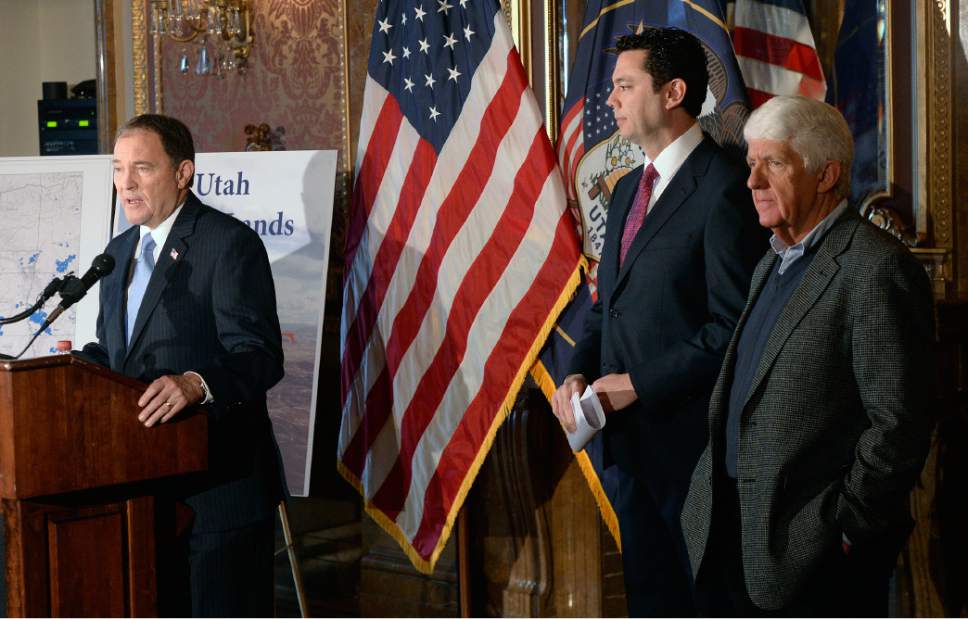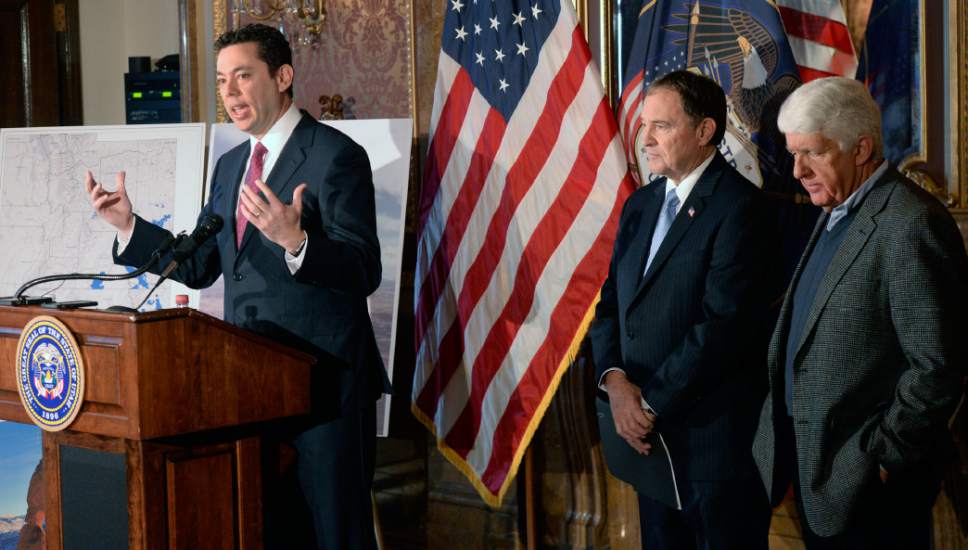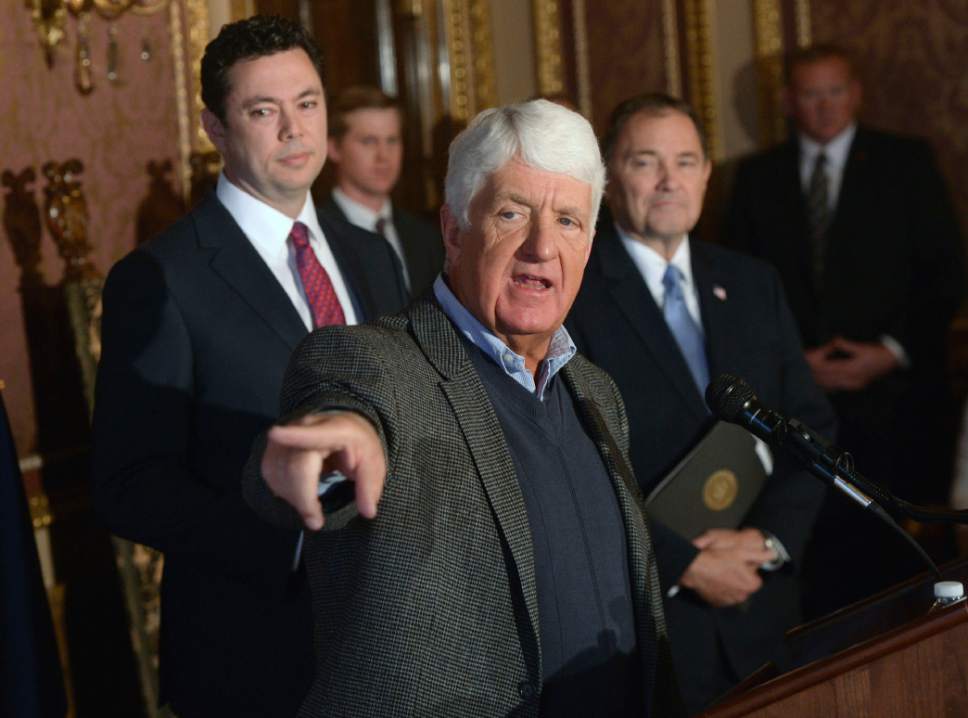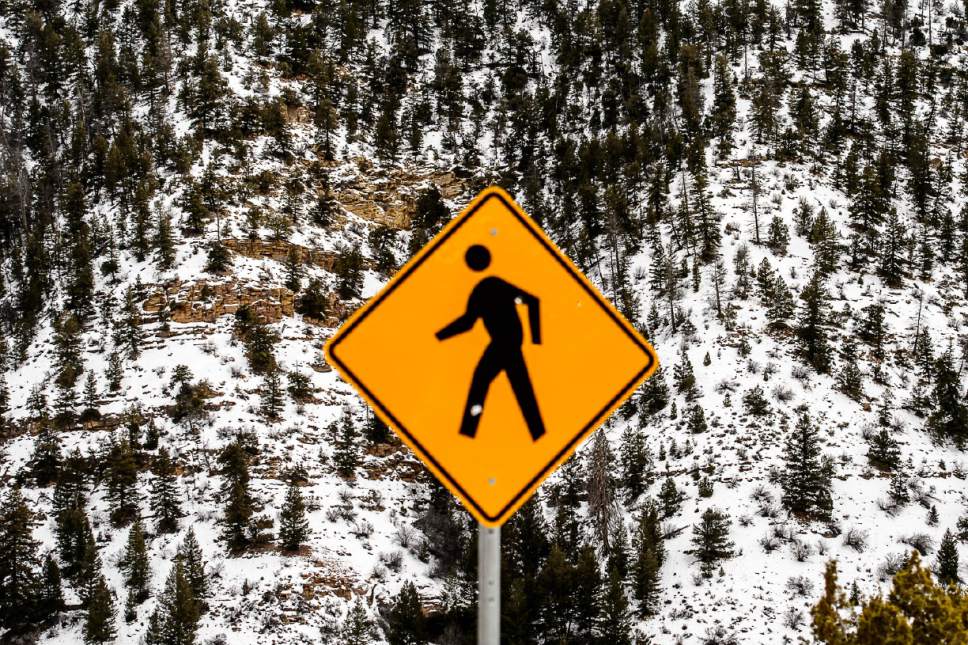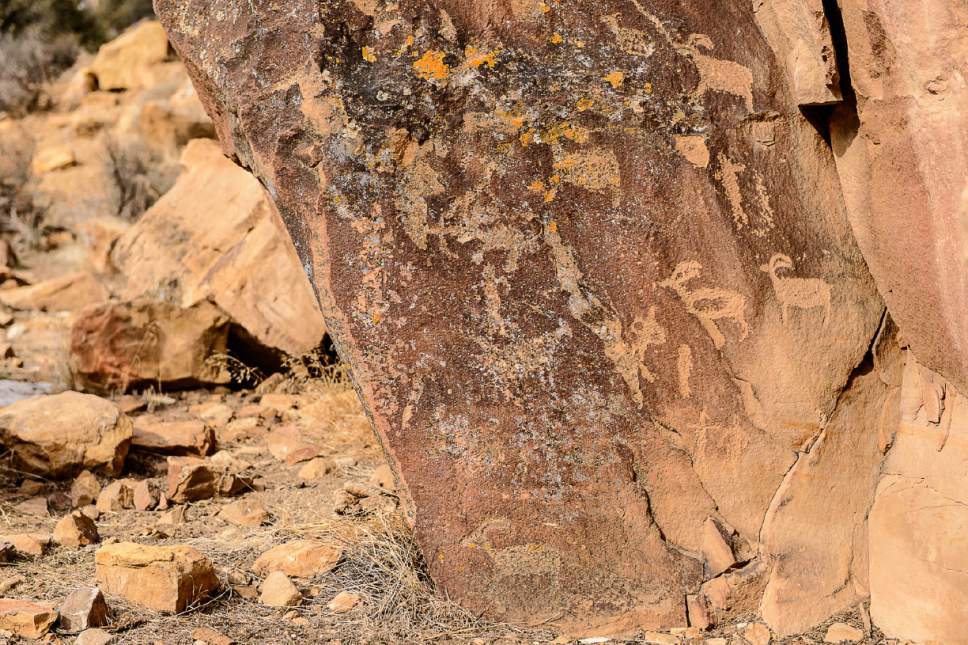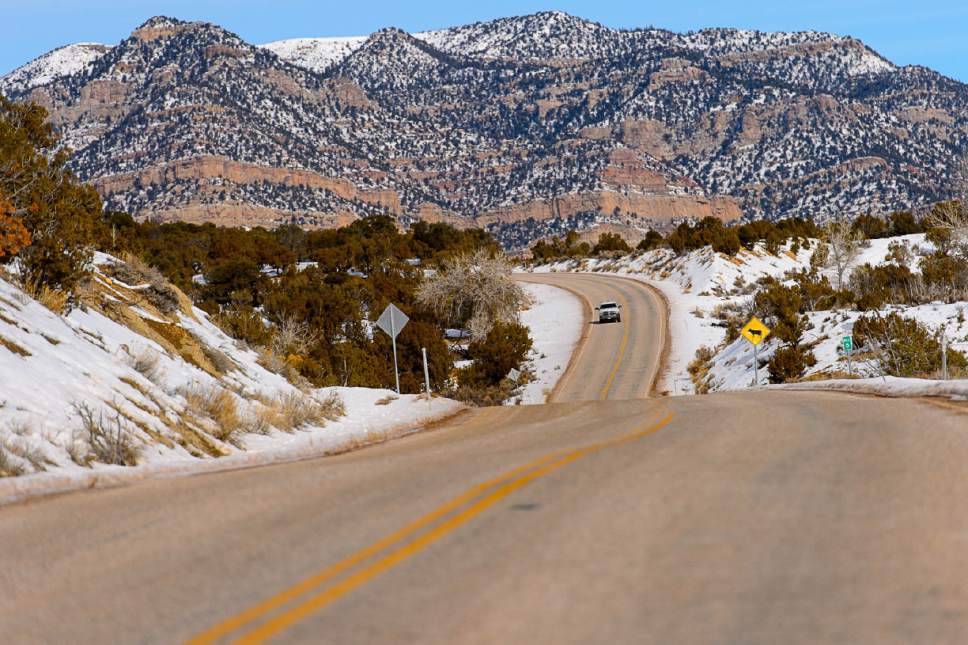This is an archived article that was published on sltrib.com in 2016, and information in the article may be outdated. It is provided only for personal research purposes and may not be reprinted.
In what they characterized as a sweeping gesture of compromise, Reps. Rob Bishop and Jason Chaffetz unveiled their plan to resolve decades of deadlock over how eastern Utah's public lands are managed even as environmental and tribal groups declared the proposal "dead on arrival" and a shameless giveaway to oil and gas interests.
On Wednesday at the state's Capitol, the Republican congressmen released a "discussion draft" of a bill that would set aside special landscapes like Cedar Mesa, San Rafael Swell and Labyrinth Canyon, while expediting mineral development in areas deemed less worthy of protection.
"There is something here for everyone to like and something for everyone to hate," Bishop said, "but if you look at the totality of what we are doing, it is moving us so far forward, there is value in it."
The Utah Public Lands Initiative Act, or PLI, crafted after 1,200 meetings hosted by Bishop and Chaffetz over the past three years, "is rooted in the belief that conservation and economic development can coexist and make Utah a better place to live, work, and visit," their offices wrote in a summary of the bill that would affect 18 million acres of public land in seven counties.
Bishop said the bill rests on four pillars: certainty, recreation, economic development and conservation.
"It will be one of the largest conservation bills in the lower 48 states that has ever been proposed, but in addition to that we want areas open for economic development," Bishop said. "They will be guaranteed for economic development so that we can pay for our schools and provide good paying jobs for Utah citizens. Recreation is no longer just allowed it is guaranteed."
The 65-page draft still has to be finalized, introduced into Congress — Utah Sen. Mike Lee has agreed to be the Senate sponsor — and passed before President Barack Obama leaves office next year.
It is widely assumed Obama will "unilaterally" designate a national monument in Utah, most likely in San Juan County, unless strong conservation measures are approved for some of the state's unprotected scenic and cultural wonders.
The participating counties are San Juan, Grand, Emery, Carbon, Uintah, Duchesne and Summit. Daggett had been the first to propose a plan for inclusion in the bill, but then pulled out of the process after a change in county leadership in the 2014 election.
The draft released Wednesday would afford protective status on 4.3 million acres, including measures to expand Arches National Park; create a small national monument at Cleveland-Lloyd Dinosaur Monument; and designate 41 wilderness and 14 national conservation areas, or NCAs, including 1.1 million acres surrounding Bears Ears buttes.
It would also bar future presidents' use of the Antiquities Act to designate national monuments in the seven counties, although this language has yet to be finished. This aspect of the bill is non-negotiable as far as Chaffetz and Bishop are concerned.
"If we cannot put an end to the constant litigation and dogmatic battles, there is no point in going forward on this. The certainty of what we're doing has to be there, especially if we look at what happened in Nevada where local governments came to an agreement and then last year the president unilaterally changed all of that," Bishop said, referring to the recent designation of Basin and Range National Monument in that state's Lincoln County.
Also in the name of "long-term certainty," the draft would strip millions of acres of impediments to oil and gas development and hand over thousands of disputed routes to the state, including some that apparently cross areas designated for protection.
These provisions drew heated barbs from some conservation groups, which called them "poison pills."
In October 2014, Chaffetz told The Salt Lake Tribune editorial board that disputed road claims would not be part of the bill. Yet these claims are a hallmark of the draft released Wednesday, drawing an intense rebuke from the Southern Utah Wilderness Alliance.
Executive Director Scott Groene characterized the draft as an "un-wilderness bill" because it could open much of these public lands to drilling while offering them little meaningful protection — because it authorizes most of the routes that counties have claimed under a frontier-era law, RS 2477, to run through them. Counties can claim title to routes over public lands if they can show 10 years of continuous use prior to the law's repeal in 1976.
"There is no fixing this bill. It is bad for wilderness, bad for public lands and bad for climate change," Groene said. "There's no resolution or balance here. Either the state gets the route, or if they don't get it, they get to keep fighting over it in court. Conservation gets nothing in this [road] provision. It's totally one-sided to give the county commissioners these crazy route claims they have been going after for decades."
Chaffetz shot back that the PLI would accomplish more conservation in Utah than SUWA and its allies could.
"We are coming at this from the most sincere parts of our hearts to find that balanced approach. It's not some message bill. This is a true effort to bring together disparate groups and try to stop fighting and have certainty and know that we've got economic development, knowing that we are preserving some of the most pristine areas in the world," Chaffetz said. "There are radical environmentalists who say it's dead on arrival. Shame on them. We have tried for two years to come at something reasonable. We have gone far, far beyond what I thought we could actually do.
San Juan County Commission Chairman Phil Lyman, who wants to see more local control for counties like his that are predominantly federally managed, was undecided on how he feels about the draft.
"We're looking at it from a broader perspective of living with this decision for a long time to come," said Lyman, recently sentenced to 10 days in jail for organizing an ATV protest ride through Recapture Canyon. "It has the potential to do some really good things. Unfortunately, it has the potential to do some really harmful things to the area. It comes to trust relationship, and I don't trust the players on the other side. I don't think they have our interests in mind."
Joining the congressmen at a podium in the Capitol's Gold Room, Gov. Gary Herbert gave the draft PLI a hearty endorsement, calling it not the end of the centurylong tug of war over Utah's public land, but a new beginning for finding lasting solutions and a template for moving forward.
"This is heavy lifting, but great work. There are people on both sides, not just the environmental side but also on the far right, that will criticize this because they don't get everything they want. That's the spirit of compromise," Herbert said. "The congressmen have done a great job finding the sweet spot of what makes good old common sense. ….What people ought to be looking at is, 'What do we get?' There are a lot of good things for everybody."
The draft sets aside 2.3 million acres of wilderness and 1.9 million acres in NCAs. Wilderness designation accords public land with the greatest level of protection, barring any mechanized equipment and permanent structures, while NCAs "offer greater flexibility for multiple-uses and opportunities for local involvement in the land management process."
But Bishop's bill precluded Class I airshed status for these new wilderness areas, which some groups contend will enable drilling right up to their borders.
"What profiteth a state to set aside pristine redrock landscapes, only to allow them to be polluted with bad air quality from drilling and mining?" Salt Lake City Democratic Rep. Joel Briscoe said. "That provision alone suggests that the real impetus behind the PLI is profit, not protection. ... I hope that members of Congress will see this for what it is and vote it down."
Bishop also envisions a series of land swaps and conveyances for local development projects and to consolidate state trust lands in areas with mineral potential in the Uinta Basin. In the deal, the School and Institutional Trust Lands Administration (SITLA) would trade about 36,000 roadless acres in the Book Cliffs that are cherished by sportsmen for big game hunting.
But the Ute Tribe blasted the provision that would cede to SITLA mineral-rich lands within the historic boundaries of its Uncompahgre Reservation.
"Discussions were kept secret and now the bill proposes to give away our most valuable resources," said Shaun Chapoose, the tribe's business committee chairman.
"While the bill may resolve issues for Utah, it largely ignores Utah's Indian tribes," the tribal committee said in a prepared statement. "If Congressman [sic] Bishop and Chaffetz did not want to fix land management problems on Indian lands, then they should have left our lands out of their bill. Instead, the bill proposes to take Indian lands and resources to fix Utah's problems."
The Department of the Interior, which administers most of the land in play, declined to stake an official position on the draft, but indicated it looks forward to hearing from stakeholders
"We appreciate Congressmen Bishop and Chaffetz's work to lead a conversation on this topic. Given the real risks these resources face, we share a sense of urgency to protect these special places for current and future generations," said spokeswoman Jessica Kershaw. "It's important that any proposal include meaningful conservation — both in name and practice — and that the land management provisions do not roll back critical stewardship tools and authorities, such as the Antiquities Act. We remain concerned by the assertion from Tribes that their voices are not reflected in this proposal regarding their ancestral lands."
The Western Energy Alliance endorsed the bill, although it still needed to evaluate it.
"We understand that compromise is necessary," said Kathleen Sgamma, the trade group's public policy director. "We applaud the concept of energy planning areas that are primarily focused on energy development, and understand that in return other areas will be designated for conservation. We are concerned that prospective areas are being placed off-limits, since advances in technology have enabled the oil and natural gas industry to reduce the impact on the land by as much as 70 percent, and improved reclamation means that the impact from development is small and temporary."
She was disturbed environmentalist were quick to pan the proposal.
"If 4.3 million acres isn't enough, then what is enough?" Sgamma asked.
Reporters Emma Penrod and Thomas Burr contributed to this report.
Brian Maffly covers public lands for The Salt Lake Tribune. Maffly can be reached at bmaffly@sltrib.com or 801-257-8713. Twitter: @brianmaffly —
A closer look
Reps. Rob Bishop and Jason Chaffetz's long-awaited draft of the Utah Public Lands Initiative Act, being released Wednesday, purports to balance conservation and the opportunity to resolve land-use conflicts in seven eastern Utah counties — San Juan, Grand, Emery, Carbon, Uintah, Duchesne and Summit.
Here is a summary of the 65-page "discussion" draft so far available.
Conservation • The document calls for:
• 41 new wilderness areas totaling 2.3 million acres, including Desolation Canyon, Candland Mountain, a 26,701-acre addition to the High Uintas, Mancos Mesa, Cheesebox Canyon, Dark Canyon, Cedar Mesa, Mexican Mountain, Range Creek and Butler Wash.
• 14 new national conservation areas totaling 1.8 million acres of Bureau of Land Management land, including Bears Ears, White River, Diamond Mountain, San Rafael Swell, Labyrinth Canyon, Book Cliffs and Nine Mile Canyon.
• Expanding Arches National Park by 19,255 acres to protect the view behind Delicate Arch.
• Establishing seven special management areas covering 94,958 acres on U.S. Forest Service lands.
• Establishing the 867-acre Jurassic National Monument at Cleveland Lloyd Dinosaur Quarry.
• Designating 301 miles of wild and scenic river on the Colorado, Green, Dolores, San Juan and Dark Canyon rivers.
• Creating an 110,838-acre Ashley Creek Recreational and Special Management area.
Opportunity • The draft also speeds development access to some areas. It would:
• Expedite drilling in areas deemed "open" to mineral development.
• Convey title to thousands of disputed road segments to the state.
• Bar future Antiquities Act monument designations.
• Consolidate 336,441 acres of School and Institutional Trust Lands (SITLA) through land swaps that would safeguard nearly 36,000 roadless acres in the Book Cliffs from energy development.
• Release 80,797 acres from wilderness study.
• Create a 13,321-acre Price Canyon State Forest.
• Expand Goblin Valley State Park and create a 156,540-acre "co-management" area extending into the San Rafael Swell.
• Convey 23 federally owned areas totaling 40,449 acres to state and local entities to facilitate public use, such as the expansion of the Canyonlands Field Airport, the Hole-in-the-Rock Trail, the creation of Fantasy Canyon State Park, an expansion of the University of Utah's Range Creek Research Station and the creation of a Seep Ridge utility corridor.
• "Dispose" of 5,094 acres in Emery County.
• Promote economic development for Native American communities, although these sections remain blank.
• Establish a 93-mile OHV trail connecting the town of Green River with Grand Junction, Colo.
• Establish recreation zones covering 375,689 acres in Canyon Country, including two areas in San Juan County for motorized recreation.


